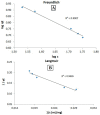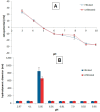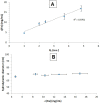Tangential Flow Ultrafiltration Allows Purification and Concentration of Lauric Acid-/Albumin-Coated Particles for Improved Magnetic Treatment
- PMID: 26287178
- PMCID: PMC4581297
- DOI: 10.3390/ijms160819291
Tangential Flow Ultrafiltration Allows Purification and Concentration of Lauric Acid-/Albumin-Coated Particles for Improved Magnetic Treatment
Abstract
Superparamagnetic iron oxide nanoparticles (SPIONs) are frequently used for drug targeting, hyperthermia and other biomedical purposes. Recently, we have reported the synthesis of lauric acid-/albumin-coated iron oxide nanoparticles SEON(LA-BSA), which were synthesized using excess albumin. For optimization of magnetic treatment applications, SPION suspensions need to be purified of excess surfactant and concentrated. Conventional methods for the purification and concentration of such ferrofluids often involve high shear stress and low purification rates for macromolecules, like albumin. In this work, removal of albumin by low shear stress tangential ultrafiltration and its influence on SEON(LA-BSA) particles was studied. Hydrodynamic size, surface properties and, consequently, colloidal stability of the nanoparticles remained unchanged by filtration or concentration up to four-fold (v/v). Thereby, the saturation magnetization of the suspension can be increased from 446.5 A/m up to 1667.9 A/m. In vitro analysis revealed that cellular uptake of SEON(LA-BSA) changed only marginally. The specific absorption rate (SAR) was not greatly affected by concentration. In contrast, the maximum temperature Tmax in magnetic hyperthermia is greatly enhanced from 44.4 °C up to 64.9 °C by the concentration of the particles up to 16.9 mg/mL total iron. Taken together, tangential ultrafiltration is feasible for purifying and concentrating complex hybrid coated SPION suspensions without negatively influencing specific particle characteristics. This enhances their potential for magnetic treatment.
Keywords: hyperthermia; nanoparticle concentration; nanoparticle purification; specific absorption rate (SAR); superparamagnetic iron oxide nanoparticles (SPIONs); tangential ultrafiltration.
Figures








Similar articles
-
Selection of potential iron oxide nanoparticles for breast cancer treatment based on in vitro cytotoxicity and cellular uptake.Int J Nanomedicine. 2017 Apr 19;12:3207-3220. doi: 10.2147/IJN.S132369. eCollection 2017. Int J Nanomedicine. 2017. PMID: 28458541 Free PMC article.
-
Development of a lauric acid/albumin hybrid iron oxide nanoparticle system with improved biocompatibility.Int J Nanomedicine. 2014 Oct 20;9:4847-66. doi: 10.2147/IJN.S68539. eCollection 2014. Int J Nanomedicine. 2014. PMID: 25364244 Free PMC article.
-
Studies on the adsorption and desorption of mitoxantrone to lauric acid/albumin coated iron oxide nanoparticles.Colloids Surf B Biointerfaces. 2018 Jan 1;161:18-26. doi: 10.1016/j.colsurfb.2017.09.057. Epub 2017 Sep 28. Colloids Surf B Biointerfaces. 2018. PMID: 29035747
-
Magnetic fluid hyperthermia: focus on superparamagnetic iron oxide nanoparticles.Adv Colloid Interface Sci. 2011 Aug 10;166(1-2):8-23. doi: 10.1016/j.cis.2011.04.003. Epub 2011 Apr 30. Adv Colloid Interface Sci. 2011. PMID: 21601820 Review.
-
Photo-fluorescent and magnetic properties of iron oxide nanoparticles for biomedical applications.Nanoscale. 2015 May 14;7(18):8209-32. doi: 10.1039/c5nr01538c. Nanoscale. 2015. PMID: 25899408 Review.
Cited by
-
Advances in Magnetic Nanoparticles Engineering for Biomedical Applications-A Review.Bioengineering (Basel). 2021 Sep 30;8(10):134. doi: 10.3390/bioengineering8100134. Bioengineering (Basel). 2021. PMID: 34677207 Free PMC article. Review.
-
Impact of Superparamagnetic Iron Oxide Nanoparticles on Vocal Fold Fibroblasts: Cell Behavior and Cellular Iron Kinetics.Nanoscale Res Lett. 2017 Dec;12(1):284. doi: 10.1186/s11671-017-2045-5. Epub 2017 Apr 20. Nanoscale Res Lett. 2017. PMID: 28431461 Free PMC article.
-
Mitoxantrone and Mitoxantrone-Loaded Iron Oxide Nanoparticles Induce Cell Death in Human Pancreatic Ductal Adenocarcinoma Cell Spheroids.Materials (Basel). 2023 Apr 6;16(7):2906. doi: 10.3390/ma16072906. Materials (Basel). 2023. PMID: 37049199 Free PMC article.
-
Selection of potential iron oxide nanoparticles for breast cancer treatment based on in vitro cytotoxicity and cellular uptake.Int J Nanomedicine. 2017 Apr 19;12:3207-3220. doi: 10.2147/IJN.S132369. eCollection 2017. Int J Nanomedicine. 2017. PMID: 28458541 Free PMC article.
-
Tissue Plasminogen Activator Binding to Superparamagnetic Iron Oxide Nanoparticle-Covalent Versus Adsorptive Approach.Nanoscale Res Lett. 2016 Dec;11(1):297. doi: 10.1186/s11671-016-1521-7. Epub 2016 Jun 14. Nanoscale Res Lett. 2016. PMID: 27299652 Free PMC article.
References
-
- Lyer S., Tietze R., Jurgons R., Struffert T., Engelhorn T., Schreiber E., Dorfler A., Alexiou C. Visualisation of tumour regression after local chemotherapy with magnetic nanoparticles—A pilot study. Anticancer Res. 2010;30:1553–1557. - PubMed
-
- Lee I.J., Ahn C.H., Cha E.J., Chung I.J., Chung J.W., Kim Y.I. Improved drug targeting to liver tumors after intra-arterial delivery using superparamagnetic iron oxide and iodized oil: Preclinical study in a rabbit model. Investig. Radiol. 2013;48:826–833. doi: 10.1097/RLI.0b013e31829c13ef. - DOI - PubMed
Publication types
MeSH terms
Substances
LinkOut - more resources
Full Text Sources
Other Literature Sources
Miscellaneous

